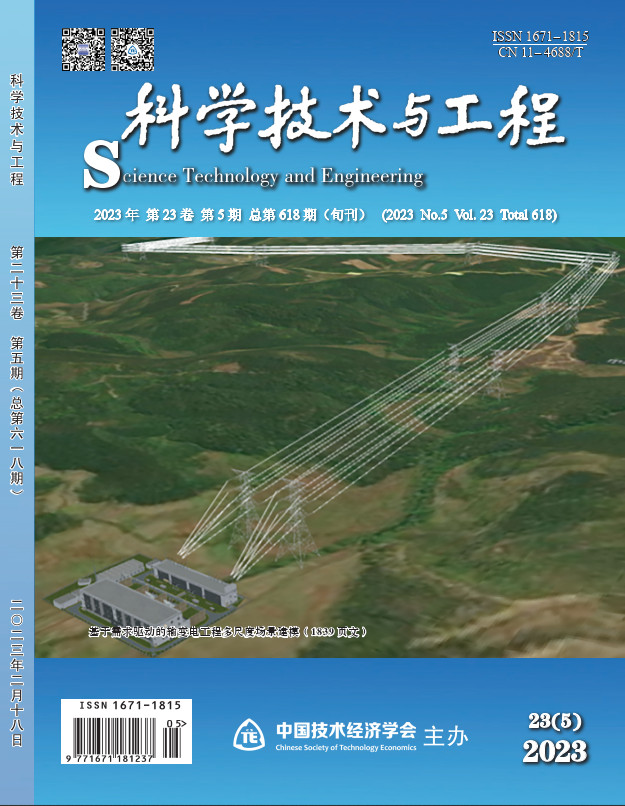Publications
Full list in `google scholar`
2025
-
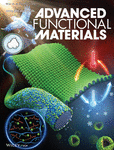 Polyanion Lattice Engineering of Na4MnV(PO4)3 Cathode for High-Performance Sodium-Ion BatteriesYifeng Yuan, Jie Wang, Aoci Yang, Xiaotong Liu, Xuan Yang, Zhaolin Li, Biwei Xiao, and Hailei ZhaoAdvanced Functional Materials, 2025
Polyanion Lattice Engineering of Na4MnV(PO4)3 Cathode for High-Performance Sodium-Ion BatteriesYifeng Yuan, Jie Wang, Aoci Yang, Xiaotong Liu, Xuan Yang, Zhaolin Li, Biwei Xiao, and Hailei ZhaoAdvanced Functional Materials, 2025The Na+ superionic conductor (NASICON)-type Na4MnV(PO4)3 (NMVP) has been considered as one of the most promising cathode materials for sodium-ion batteries because of its higher operating voltage and low cost compared to Na3V2(PO4)3. However, the Jahn-Teller effect of Mn3+ during (de)sodiation processes and the sluggish electrode reaction kinetics strongly restrict its cycling stability and rate-capability. Herein, polyanion lattice engineering is developed by SiO44− substitution on PO43− to strengthen the adjacent local environment of the active coordination octahedron and improve the structural stability. The relieved lattice local distortions induce an enhanced Na+ diffusion simultaneously. Moreover, the SiO44− substitution leads to an improved intrinsic electronic conductivity. With these synergetic effects, the as-synthesized Na4MnV(PO4)2.9(SiO4)0.1/C composite delivers a reversible specific capacity of 98.7 mAh g−1 at 0.5C and an excellent cycle stability, with 91.4% capacity retention after 200 cycles at 0.5C and 76.4% capacity retention after 1000 cycles under a high rate of 5C. Besides, significantly improved rate performance of a capacity retention (C10C/C0.5C) at 10C (77.4%) that far exceeds that of the pristine Na4MnV(PO4)3/C electrode (45.3%) is realized. This structural regulation strategy offers new insights for developing high-performance Mn-based polyanionic cathodes with superior cycling stability.
-
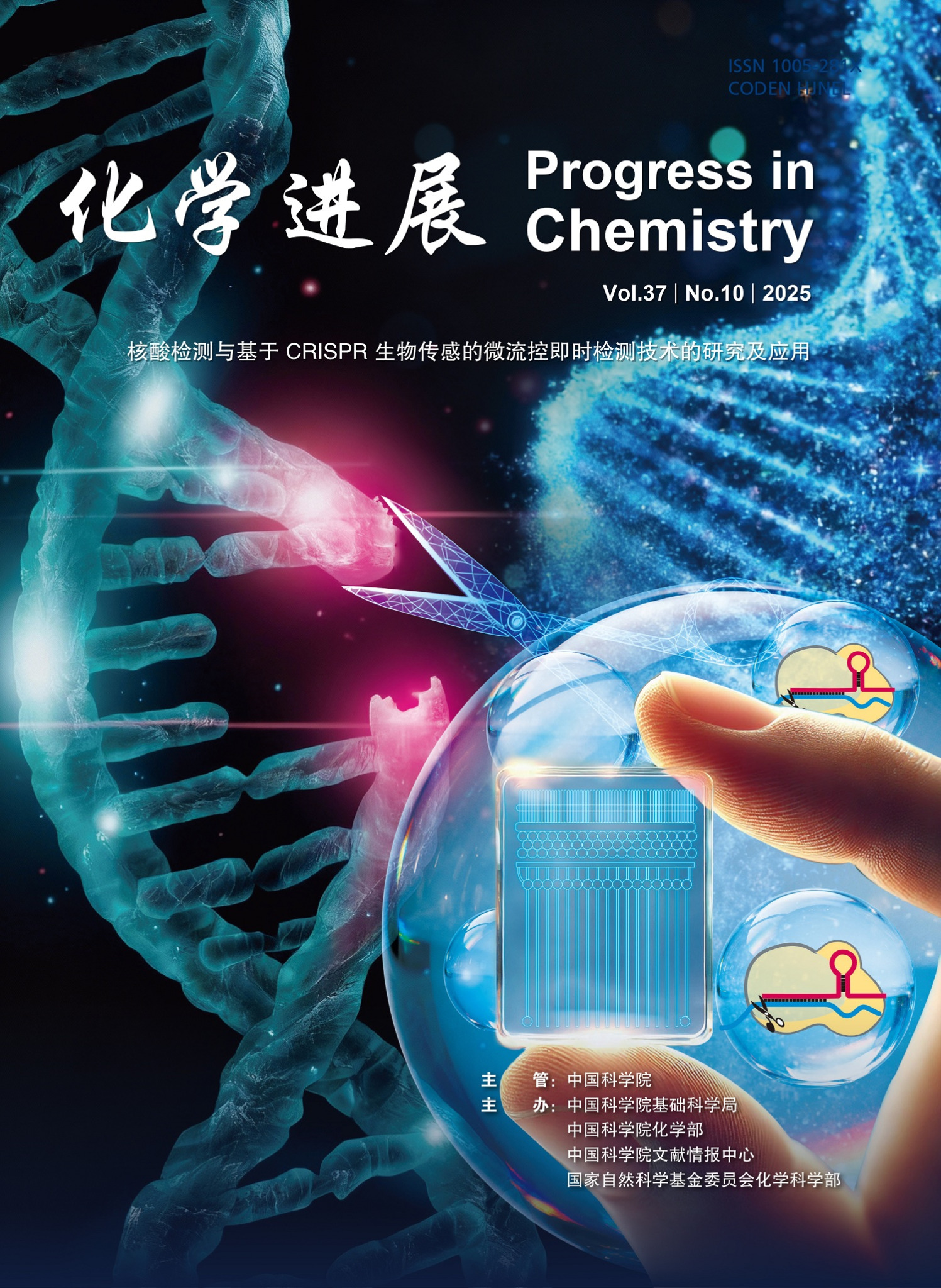 化学分子的隐藏空间嵌入方法原理和应用陈昊天, 杨涛, and 刘晓彤*化学进展, 2025
化学分子的隐藏空间嵌入方法原理和应用陈昊天, 杨涛, and 刘晓彤*化学进展, 2025化学分子的有效表示是推动化学信息学和新材料研发的关键。近年来发展出的基于数据驱动的分子表示技术,相较于传统手工设计描述符和图结构分析方法,能够有效避免噪声和信息冗余,为高效精准性质预测提供支持。嵌入表示具备高效信息压缩、数据表征增强和语义保留等特点,已广泛应用于深度学习与数据挖掘等领域。受自然语言处理领域词嵌入启发,研究者开始探索将类似方法应用于化学分子的隐藏空间构建,并提出多种用于分子性质预测和分子结构生成的嵌入方法。本综述首先阐述了机器学习中通用嵌入技术的原理,进而依次探讨了化学元素隐藏空间表示方法和化学分子隐藏空间嵌入技术。通过梳理自然语言处理、图嵌入等领域相关技术在分子嵌入中的创新应用,揭示当前分子嵌入正逐步向多模态、自监督学习和动态建模方向演进,对未来研究发展趋势提出展望。
-
 MCTSGT: A Graph Theory-based Monte Carlo Tree Strategy for Configuration Search in Disordered StructuresBing He, Zhicong Lai, Da Wang, Xiaotong Liu, Yue Liu, Miao Xu, Bowei Pu, Qingbao Wang, Ruofang Wang, Maxim Avdeev, and Siqi ShiActa Materialia, 2025
MCTSGT: A Graph Theory-based Monte Carlo Tree Strategy for Configuration Search in Disordered StructuresBing He, Zhicong Lai, Da Wang, Xiaotong Liu, Yue Liu, Miao Xu, Bowei Pu, Qingbao Wang, Ruofang Wang, Maxim Avdeev, and Siqi ShiActa Materialia, 2025Crystalline solids, especially ion conductors, often exhibit site-occupancy disorder, including partial occupation of the mobile ion sublattice or mixed occupation of the framework sublattice. The key to predicting physical properties, such as ionic transport barrier, lies in identifying appropriate configurations that can reflect the local features of site-occupancy disorder. However, as supercell size and compositional complexity increase, existing configuration search methods suffer from low search efficiency and insufficient universality. Here, we propose a multi-strategy configuration search method called MCTSGT, where the search space is represented as a tree structure using Monte Carlo Tree Search (MCTS) and equivalent nodes are dynamically pruned using the distance matrix of graph theory (GT) to improve search efficiency. Two alternative search strategies, Warren-Cowley short-range order parameters and configurational ground-state energy, are provided to enhance the adaptability of MCTSGT for different systems. Applied to nine typical disordered structures, MCTSGT achieves a maximum search efficiency improvement of 14% compared to Monte Carlo simulated annealing. Furthermore, energy barriers of obtained configurations via the bond valence site energy (BVSE) method exhibit a consistent trend with experimental studies. Our work provides important insights into machine-learning modeling of disordered structures and contributes to materials discovery across a broader compositional space.
-
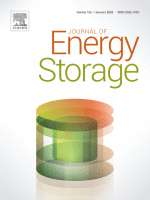 Using data-driven methods to analyze the roles of different elements in liquid metal batteriesZiming Wang, Yipeng Liu, Yu Hong, Jiyuan Zhang, Tao Yang, Xiaotong Liu, and Hailei ZhaoJournal of Energy Storage, 2025
Using data-driven methods to analyze the roles of different elements in liquid metal batteriesZiming Wang, Yipeng Liu, Yu Hong, Jiyuan Zhang, Tao Yang, Xiaotong Liu, and Hailei ZhaoJournal of Energy Storage, 2025As an excellent energy storage technology, liquid metal batteries (LMBs) have gained significant attention recently. For these batteries, because lithium is commonly used as the anode, the specific energy capacity and charge–discharge performance mainly depend on the cathode. Therefore, the selection of the cathode material is extremely important. Designing this material involves finding an optimal combination of elements. Despite limited data, machine learning techniques can still be employed to conduct meaningful research. In this work, we developed a new evaluation method that not only focuses on energy density, which has been the primary focus in previous studies, but also considers rate performance of the battery system. The entire workflow of the method includes regression with different models, numerical differentiation, correlation coefficient calculation, and variance inflation factor evaluation. Based on the elements in our current dataset (including Te, Se, Sb, Cu, Zn, Bi, Sn and Pb), the importance degree sequences of these elements in terms of energy density and rate capability are delivered. Considering the overall performance, we suggest that Te and Se are particularly promising candidates for cathode materials. Finally, we discuss the quantitative results in the context of conventional qualitative understanding in electrochemistry, and we find that they are consistent and without contradiction. We have open-sourced the curated dataset and all relevant codes and we believe that as more research is conducted and data are accumulated, expanding the dataset to include more elements will yield even more promising results.
-
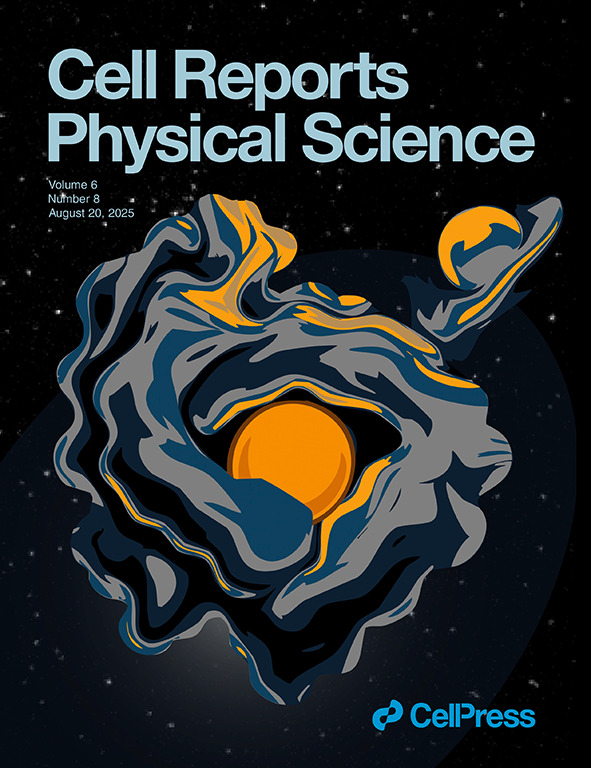 Exploring lightweight language models for materials informatics with AlchemBERTYuhang Wang, Xiaotong Liu, Haotian Chen, Tao Yang, Xingchen Liu, and Xiaodong WenCell Reports Physical Science, 2025
Exploring lightweight language models for materials informatics with AlchemBERTYuhang Wang, Xiaotong Liu, Haotian Chen, Tao Yang, Xingchen Liu, and Xiaodong WenCell Reports Physical Science, 2025Generating candidate materials using large language models (LLMs) based on desired properties is logically impossible without accurate property predictions. Using Matbench, we report our adaptation of the 110-million-parameter BERT-base model (named AlchemBERT) and show that, although far smaller than generative pre-trained transformer (GPT), it attains accuracy comparable with language models holding billions of parameters. On both composition and structure benchmarks, it reaches the performance of the composition-only reference model CrabNet and surpasses it on several tasks. For structure benchmarks, we compare crystallographic information files (CIFs) with natural language (NL) descriptions, and for composition benchmarks, we compare raw chemical formulas with NL; overall, NL input lowers the mean absolute error (MAE) by 40.3% relative to CIFs or formulas. Across datasets of 100–100,000 samples, AlchemBERT frequently outperforms structure-based and knowledge-driven baselines. These results show that compact LLMs coupled with flexible NL encodings can unify composition and structure reasoning, providing a practical template for accelerating data-driven materials discovery.
-
 AlchemBERT: Exploring Lightweight Language Models for Materials InformaticsXiaotong Liu, Yuhang Wang, Tao Yang, Xingchen Liu, and Xiaodong WenChemRxiv, 2025This content is a preprint and has not been peer-reviewed
AlchemBERT: Exploring Lightweight Language Models for Materials InformaticsXiaotong Liu, Yuhang Wang, Tao Yang, Xingchen Liu, and Xiaodong WenChemRxiv, 2025This content is a preprint and has not been peer-reviewedThe emergence of large language models (LLMs) has spurred numerous applications across various domains, including material design. In this field, an increasing number of generative models focus on directly generating materials with desired properties more accurately, moving away from the traditional approach of enumerating vast numbers of candidates and relying on computationally intensive screening algorithms. However, we assert that without accurate prediction capabilities, effective material design is unattainable, as generating necessary structures becomes futile if their quality cannot be reliably evaluated. Matbench provides an excellent foundation for predictive tasks, yet prior efforts with LLMs have primarily focused on composition-related tasks using models such as GPT or LLaMA. In this study, we revisit BERT, a relatively small LLM with 110 million parameters, which is significantly smaller than GPT or LLaMA models containing billions of parameters. Remarkably, we demonstrate that BERT-base achieves comparable performance to these larger models in material property prediction tasks. Extending beyond composition tasks, we introduce BERT’s application in structure prediction using CIF (Crystallographic Information File) data and natural language descriptions of structures. Our results rival state-of-the-art composition models such as CrabNet and, in several tasks across datasets ranging from a few hundred to over a hundred thousand samples, even surpass traditional structure-based and knowledge-driven models. Additionally, on the latest Matbench test task, Matbench-Discovery, our model outperformed the Voronoi RF model and achieved MAE results comparable to other models that rely solely on energy predictions. Our findings provide a new reference point for future LLM applications in material design, offering valuable insights for leveraging language model in this domain and emphasizing natural language descriptions over conventional model-centric design. We term this application of BERT in material design AlchemBERT, signifying its novel role in bridging natural language and structural representations.
2024
-
 Size-Dependent Thermodynamic Stability of Copper Sulfide NanoparticlesMeimin Hu, Jinjia Liu, Wenping Guo, Xiaotong Liu, Gian-Marco Rignanese, and Tao YangChemistry of Materials, 2024
Size-Dependent Thermodynamic Stability of Copper Sulfide NanoparticlesMeimin Hu, Jinjia Liu, Wenping Guo, Xiaotong Liu, Gian-Marco Rignanese, and Tao YangChemistry of Materials, 2024Copper sulfide nanoparticles are extensively employed in the field of functional materials. However, synthesizing the desired nanoparticles in a controlled manner is challenging due to the variety of copper sulfide phases and their potential transformations. Here, we utilize a unified theoretical approach combining a high-throughput computational workflow, ab initio atomistic thermodynamics, and the Wulff theorem to study the thermodynamic stability of copper sulfide nanoparticles. Theoretical size-dependent phase diagrams are constructed for the first time, considering various sulfur chemical potentials. This study unveils the evolution of crystal morphology under varying external conditions and underlines the crucial role of surface energy in maintaining the stability of copper sulfide nanoparticles. Our findings offer a theoretical guide for experimental endeavors aimed at synthesizing the desired surface morphology and phases of copper sulfide nanomaterials.
2023
-
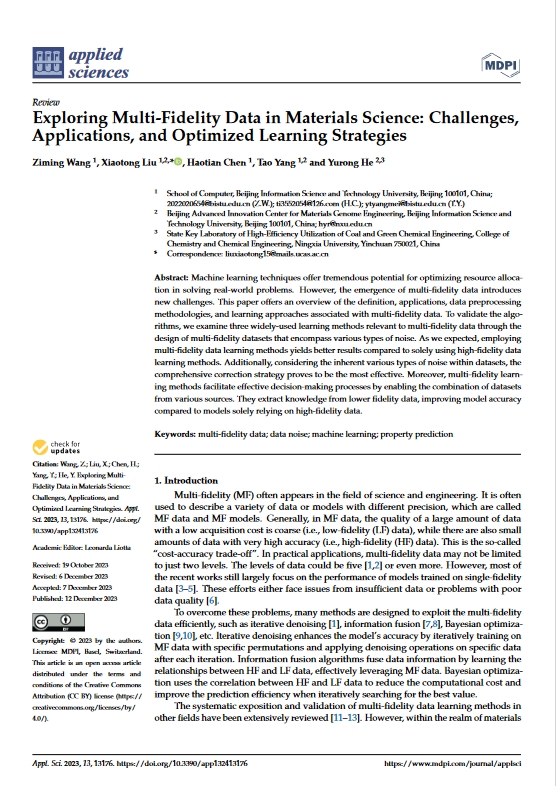 Exploring Multi-Fidelity Data in Materials Science: Challenges, Applications, and Optimized Learning StrategiesZiming Wang, Xiaotong Liu, Haotian Chen, Tao Yang, and Yurong HeApplied Sciences, 2023
Exploring Multi-Fidelity Data in Materials Science: Challenges, Applications, and Optimized Learning StrategiesZiming Wang, Xiaotong Liu, Haotian Chen, Tao Yang, and Yurong HeApplied Sciences, 2023Machine learning techniques offer tremendous potential for optimizing resource allocation in solving real-world problems. However, the emergence of multi-fidelity data introduces new challenges. This paper offers an overview of the definition, applications, data preprocessing methodologies, and learning approaches associated with multi-fidelity data. To validate the algorithms, we examine three widely-used learning methods relevant to multi-fidelity data through the design of multi-fidelity datasets that encompass various types of noise. As we expected, employing multi-fidelity data learning methods yields better results compared to solely using high-fidelity data learning methods. Additionally, considering the inherent various types of noise within datasets, the comprehensive correction strategy proves to be the most effective. Moreover, multi-fidelity learning methods facilitate effective decision-making processes by enabling the combination of datasets from various sources. They extract knowledge from lower fidelity data, improving model accuracy compared to models solely relying on high-fidelity data.
-
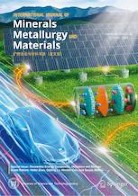 Speeding up the prediction of C–O cleavage through bond valence and charge on iron carbidesYurong He, Kuan Lu, Jinjia Liu, Xinhua Gao, Xiaotong Liu, Yongwang Li, Chunfang Huo, James P Lewis, Xiaodong Wen, and Ning LiInternational Journal of Minerals, Metallurgy and Materials, 2023
Speeding up the prediction of C–O cleavage through bond valence and charge on iron carbidesYurong He, Kuan Lu, Jinjia Liu, Xinhua Gao, Xiaotong Liu, Yongwang Li, Chunfang Huo, James P Lewis, Xiaodong Wen, and Ning LiInternational Journal of Minerals, Metallurgy and Materials, 2023The activation of CO on iron-based materials is a key elementary reaction for many chemical processes. We investigate CO adsorption and dissociation on a series of Fe, Fe3C, Fe5C2, and Fe2C catalysts through density functional theory calculations. We detect dramatically different performances for CO adsorption and activation on diverse surfaces and sites. The activation of CO is dependent on the local coordination of the molecule to the surface and on the bulk phase of the underlying catalyst. The bulk properties and the different local bonding environments lead to varying interactions between the adsorbed CO and the surface and thus yielding different activation levels of the C–O bond. We also examine the prediction of CO adsorption on different types of Fe-based catalysts by machine learning through linear regression models. We combine the features originating from surfaces and bulk phases to enhance the prediction of the activation energies and perform eight different linear regressions utilizing the feature engineering of polynomial representations. Among them, a ridge linear regression model with 2nd-degree polynomial feature generation predicted the best CO activation energy with a mean absolute error of 0.269 eV.
-
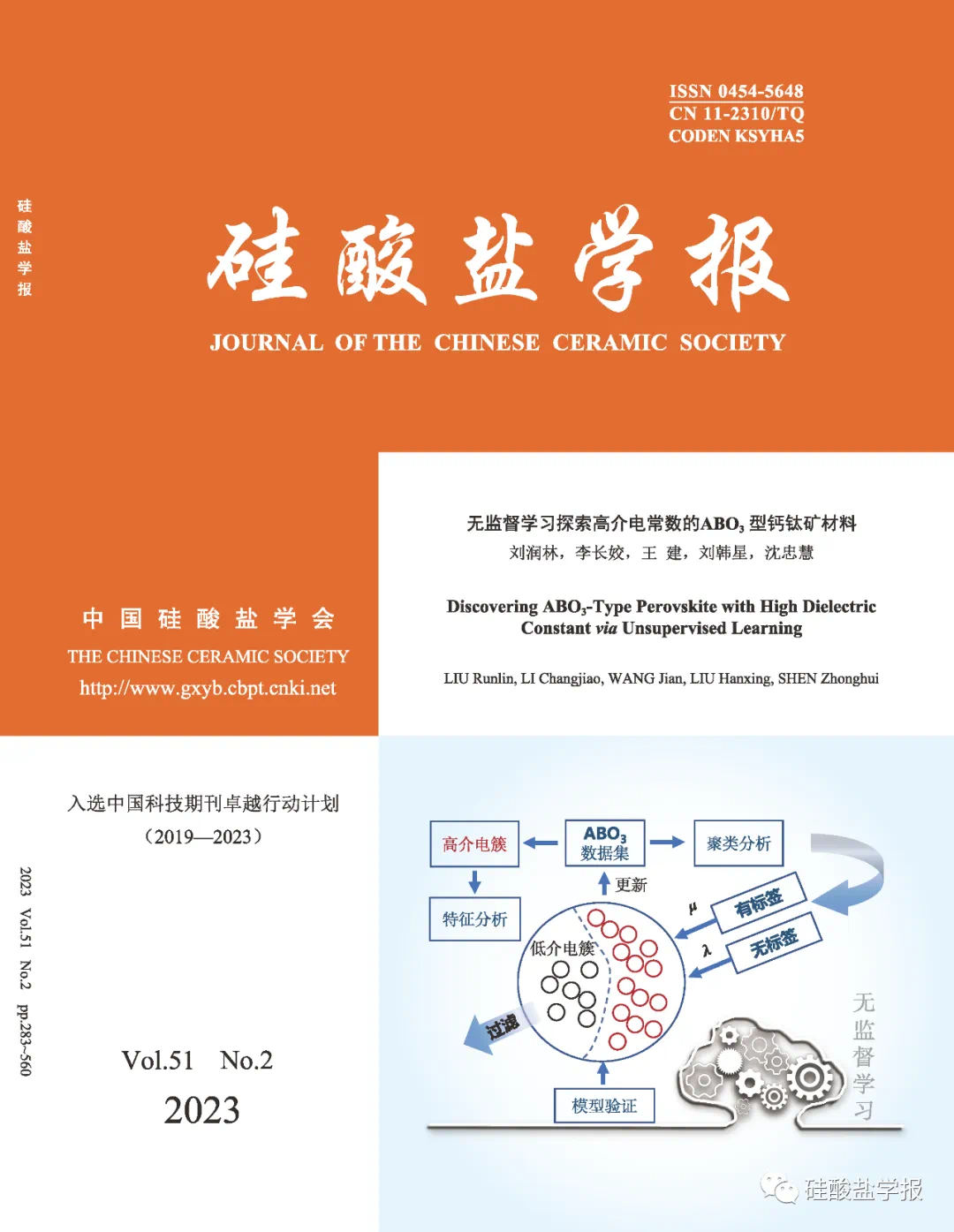 多保真度数据学习算法的定量噪声评价刘晓彤, 王滋明, 欧阳嘉华, and 杨涛硅酸盐学报, 2023
多保真度数据学习算法的定量噪声评价刘晓彤, 王滋明, 欧阳嘉华, and 杨涛硅酸盐学报, 2023多保真度数据是当前材料领域数据的主要存在形式。在数据生产端,不同量化方法在材料同种属性的计算上存在较大差距。对于数据消费端的机器学习算法,研究人员为最大化提取数据中知识设计了各种方法。采用定量噪声添加的方法,评价不同噪声强度、类型对不同多保真度数据学习方法的影响,通过迭代降噪验证数据修正方法的适用场景。结果表明:多保真度数据的利用方式至关重要,需对各子数据集中数据量及含噪情况进行综合考量。在使用不同噪声类型与强度构造出的多种数据集上,得益于数据间的协同效应,逐步删除低保真度数据的―Onion”训练方式明显优于按数据集所含噪声减小方向逐个进行的训练方式。在多保真度数据训练中,无论何种噪声强度及训练方式,线性噪声对模型的影响更小。对于采样噪声来说,在各环节更好地模拟了真实多保真度数据,建议被后续研究采用。此外,复杂噪声难以让少量真值数据发挥―纠偏”作用,更适合进行迭代降噪处理。
2022
-
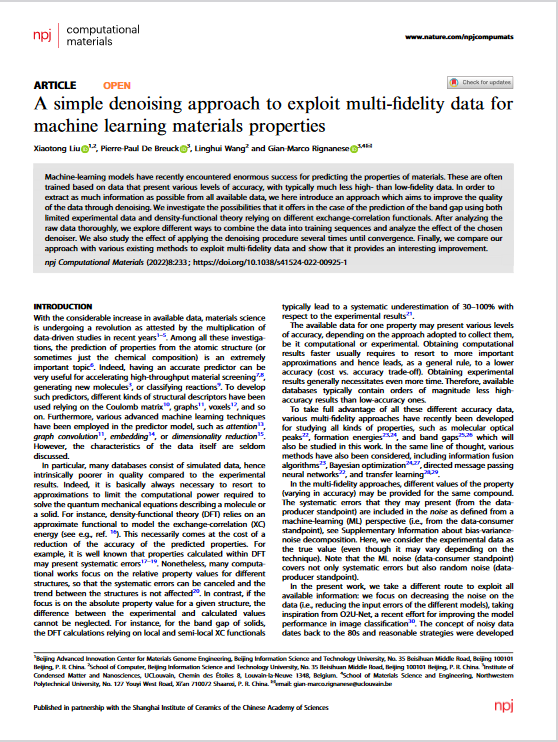 A simple denoising approach to exploit multi-fidelity data for machine learning materials propertiesXiaotong Liu, Pierre-Paul De Breuck, Linghui Wang, and Gian-Marco Rignanesenpj Computational Materials, 2022
A simple denoising approach to exploit multi-fidelity data for machine learning materials propertiesXiaotong Liu, Pierre-Paul De Breuck, Linghui Wang, and Gian-Marco Rignanesenpj Computational Materials, 2022Machine-learning models have recently encountered enormous success for predicting the properties of materials. These are often trained based on data that present various levels of accuracy, with typically much less high- than low-fidelity data. In order to extract as much information as possible from all available data, we here introduce an approach which aims to improve the quality of the data through denoising. We investigate the possibilities that it offers in the case of the prediction of the band gap using both limited experimental data and density-functional theory relying on different exchange-correlation functionals. After analyzing the raw data thoroughly, we explore different ways to combine the data into training sequences and analyze the effect of the chosen denoiser. We also study the effect of applying the denoising procedure several times until convergence. Finally, we compare our approach with various existing methods to exploit multi-fidelity data and show that it provides an interesting improvement.
2021
-
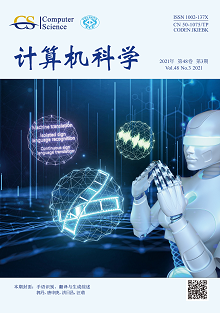 无模型强化学习研究综述秦智慧, 李宁, 刘晓彤, 刘秀磊, 佟强, and 刘旭红计算机科学, 2021
无模型强化学习研究综述秦智慧, 李宁, 刘晓彤, 刘秀磊, 佟强, and 刘旭红计算机科学, 2021强化学习(Reinforcement Learning,RL)作为机器学习领域中与监督学习、无监督学习并列的第三种学习范式,通过与环境进行交互来学习,最终将累积收益最大化。常用的强化学习算法分为模型化强化学习(Model-based Reinforcement Lear-ning)和无模型强化学习(Model-free Reinforcement Learning)。模型化强化学习需要根据真实环境的状态转移数据来预定义环境动态模型,随后在通过环境动态模型进行策略学习的过程中无须再与环境进行交互。在无模型强化学习中,智能体通过与环境进行实时交互来学习最优策略,该方法在实际任务中具有更好的通用性,因此应用范围更广。文中对无模型强化学习的最新研究进展与发展动态进行了综述。首先介绍了强化学习、模型化强化学习和无模型强化学习的基础理论;然后基于价值函数和策略函数归纳总结了无模型强化学习的经典算法及各自的优缺点;最后概述了无模型强化学习在游戏AI、化学材料设计、自然语言处理和机器人控制领域的最新研究现状,并对无模型强化学习的未来发展趋势进行了展望。
2020
-
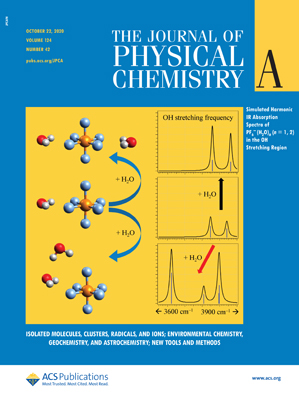 Solving chemistry problems via an end-to-end approach: A proof of conceptXiaotong Liu, Tianfu Zhang, Tao Yang, Xiulei Liu, Xin Song, Yong Yang, Ning Li, Gian-Marco Rignanese, Yongwang Li, and Xiaodong WenThe Journal of Physical Chemistry A, 2020
Solving chemistry problems via an end-to-end approach: A proof of conceptXiaotong Liu, Tianfu Zhang, Tao Yang, Xiulei Liu, Xin Song, Yong Yang, Ning Li, Gian-Marco Rignanese, Yongwang Li, and Xiaodong WenThe Journal of Physical Chemistry A, 2020Traditionally, chemistry problems are solved by means of a deductive approach. The question to be addressed is typically related to the value of a property that is either measured experimentally, computed using quantum-chemistry software, or (more recently) predicted using a machine-learned model. In this paper, we demonstrate that an inductive approach can be adopted using End-to-End (E2E) machine learning. This approach is illustrated for tackling the following chemistry problems: (i) determine the fully coordinated (FC) and undercoordinated (UC) atoms in a molecule with one missing atom, (ii) identify the type of atom that is missing in such an incomplete molecule, and (iii) predict the direction of a reaction between two molecules according to an existing dataset. The E2E approach leads to accuracies higher than 99%, 98%, and 93% for these three problems, respectively. Finally, in order to achieve such accuracies, a descriptor for the molecules, called bag of clusters, is introduced and compared with a series previously proposed descriptors, highlighting a series of advantages.
2011
-
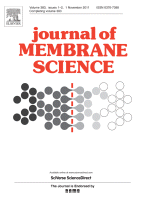 Lattice characteristics, structure stability and oxygen permeability of \(BaFe_{1-x}Y_xO_{3−δ}\) ceramic membranesXiaotong Liu, Hailei Zhao, Jianying Yang, Yuan Li, Ting Chen, Xionggang Lu, Weizhong Ding, and Fushen LiJournal of membrane science, 2011
Lattice characteristics, structure stability and oxygen permeability of \(BaFe_{1-x}Y_xO_{3−δ}\) ceramic membranesXiaotong Liu, Hailei Zhao, Jianying Yang, Yuan Li, Ting Chen, Xionggang Lu, Weizhong Ding, and Fushen LiJournal of membrane science, 2011\(BaFe_{1−x}Y_xO_{3−δ}\) (x=0–0.2) materials were synthesized by conventional solid-state reaction process for oxygen separation application. The effects of Y-doping on the crystal structure development, electrical conductivity and oxygen permeability were evaluated. Yttrium introduction effectively stabilize the cubic structure of BaFe1−xYxO3−δ. With Y-doping, the oxidation state of Fe ions reduces, resulting in the increase in oxygen vacancy concentration as charge compensation and the decreases in electrical conductivity. Y-doping enhances the structural stability of BaFe1−xYxO3−δ in reducing atmosphere but decreases the oxygen permeability. Both of them are attributed to the strong binding energy of Y–O bond. The cobalt free membrane BaFe0.95Y0.05O3−δ shows good structural stability under reducing atmosphere and acceptable oxygen permeation flux of 0.798 ml (STP) min−1 cm−2 at 900 °C for 1.1 mm thick membrane, making it a promising candidate for future practical applications.
